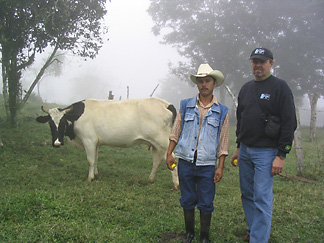New York farmers visit Mexico to probe dairy workers' lives
By Julie Berry

In January 2007 up to 10 New York state dairy farmers will head to Mexico to help better understand Central American workers back home.
"The trip is designed for farmers who hire employees from Mexico and Guatemala to experience Hispanic culture by visiting communities where dairy workers come from, and promote cross-cultural understanding in their local communities," said trip coordinator Thomas Maloney, a senior extension associate in applied economics and management at Cornell, who led a first group of eight dairy farmers to the remote mountain village of Malacatapec, Mexico, in December 2005.
"All of those of us who went have an understanding of how complex the situation is and why people come because of economics," said Maloney. "Mexicans are motivated and productive because they can make so much more money here in a shorter period of time."
Clifton Springs dairy producer John Mueller, who participated in the first trip, said, "There is no question that this understanding will make my business better. This trip to Mexico taught me why my employees eat what they eat, do what they do and think the way they think."
The timing of the trip also primes farmers to participate in current immigration reform discussions.
The study trip is part of a comprehensive approach to address needs of the farm communities and is supported by a federal extension grant. The effort also includes development of a conference on managing Hispanic workers in conjunction with Penn State University and a survey of Hispanic employees and their managers.
Participants in the first study trip flew to Veracruz and visited banana farms and other tropical agricultural operations where employees typically work 12 hours a day, six days a week for $8 to $12 a day.
In Malacatapec the participants stayed with "Teodoro," a former New York dairy employee who had initially crossed the border in 1999. Two years later, when he returned to Mexico, his U.S. earnings allowed his family to build a two-story house with running water and electricity, purchase 20 cows, plant 8,000 coffee plants and operate a small store out of their house.
"I want you to understand when your workers come from humble and simple lives we don't go to New York for fun. We do it to support our families. It's a tricky race we run. We leave children behind," Teodoro said. "If immigration dynamics were different, our time in the states would be shorter. We would travel more to see our families."
Survey of Hispanic Dairy Workers
Since the mid-1990s, the trend toward hiring Hispanic workers on New York's dairy farms has steadily increased. To document these trends, Cornell's Thomas Maloney and former state extension specialist David C. Grusenmeyer co-authored a survey to help create a demographic profile of Hispanic dairy workers on New York farms.
According to the survey of 60 farms and 111 employees, three-fourths of the Hispanic employees were from Mexico and one-fourth were from Guatemala. The employees are typically 30 years old and younger, almost always male and not highly educated. Only 51 percent have a primary school education, 25 percent completed secondary school, and 2 percent attended or graduated from a university.
The survey showed that Hispanic employees work an average of 62 hours a week. They insist on working 55 hours, or will seek work elsewhere and would prefer to work 66 hours.
Wages were on average $7.51 per hour, with a range of $5.50 to $11.50. The workers were generally provided housing and utilities in addition to their salary. Additional benefits offered by some farms included Spanish satellite TV, telephone, health insurance, retirement, vacation and sick leave, uniforms, transportation, milk and meat.
Both workers and employers identified challenges in cross-cultural employment, according to the survey report. Employees indicated that their top three challenges were crossing the border, language and lack of freedom to do what they wanted. Employers indicated that their top three obstacles were language, cross-cultural understanding and immigration issues.
Julie Berry is the Cornell Cooperative Extension dairy and livestock resource educator in Jefferson County.
Media Contact
Get Cornell news delivered right to your inbox.
Subscribe